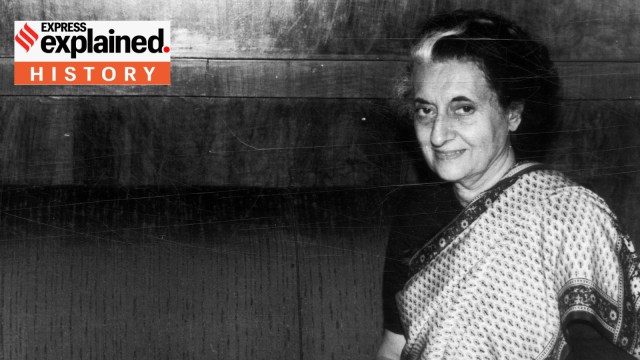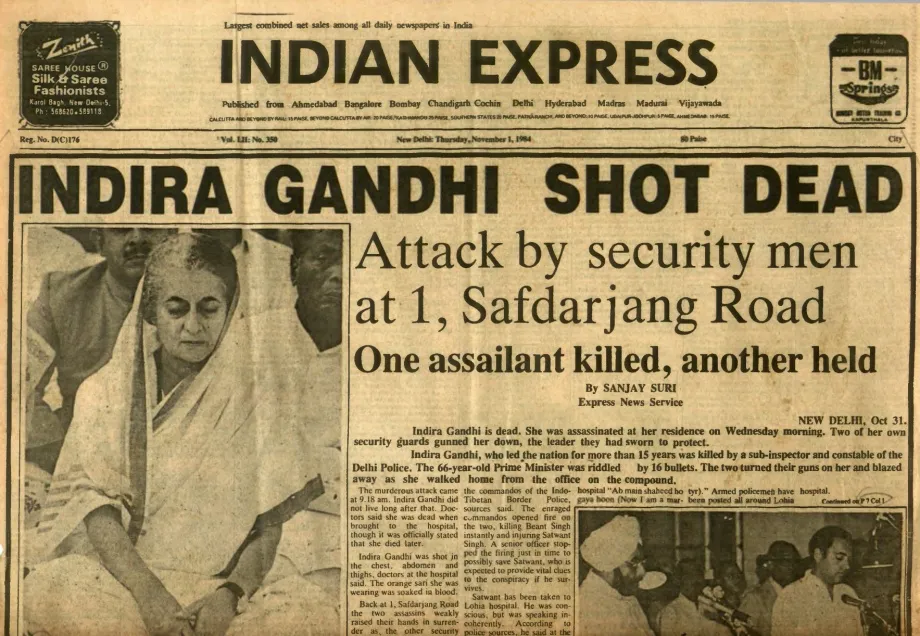What happened on Oct 31, 1984: Recalling the assassination of Indira Gandhi
39 years ago, India’s Prime Minister was assassinated by her own security guards in the aftermath of the Army action at the holy Golden Temple. What happened on that fateful day, and afterward?
 Former Indian Prime Minister Indira Gandhi. (Express archive photo)
Former Indian Prime Minister Indira Gandhi. (Express archive photo) Indira Gandhi was assassinated on October 31, 1984. Two of the Prime Minister’s bodyguards, Beant Singh and Satwant Singh, fired over 30 bullets at her from point blank range, purportedly to avenge the humiliation of Sikhs and the desecration of the Golden Temple during Operation Blue Star in June of that year.
Indira’s assassination sent shockwaves through the nation, unleashing some of the most vicious communal violence India has ever seen. In just about three days, approximately 3,350 Sikhs (government estimates) were massacred, 2,800 in the national capital itself.
This is what happened on that day 39 years ago.
 The Indian Express front page on October 31, 1984.
The Indian Express front page on October 31, 1984.
The Prime Minister had a sense of foreboding
In Operation Blue Star, the Indian Army entered Amritsar’s Golden Temple, the holiest Sikh shrine, to flush out separatists residing in the premises. While successful in its intended objectives, it caused great damage to the temple and killed anywhere between a few hundred to a thousand Sikh civilians. This enraged Sikhs worldwide, who saw Blue Star as an assault on their faith.
The Prime Minister, who had ordered the operation, bore the brunt of the blame. “Everyone knew that her life was in danger,” Katherine Frank wrote in her biography of Indira (Indira: The Life of Indira Nehru Gandhi, 2001).
In the days and months that followed Blue Star, Indira would speak about her impending demise to her family and close friends. “I had rarely seen her in such a mood, her thoughts entangled with death,” Pupul Jayakar, a close confidante and biographer, wrote (Indira Gandhi: A Biography, 2000). When Jayakar asked Indira why she was speaking about death so often, she simply responded: “Isn’t it inevitable?”
But she insisted on persisting with Sikh guards
Following Blue Star, Indira’s security was beefed up. Although she rejected transferring her security over from the police to the Army, commandos from the Indo-Tibetan Border Police were added to her protection team.
Security around her family, especially her grandchildren, Rahul (then 14), and Priyanka (12), was also stepped up. “She had an obsessive fear of her grandchildren being harmed, either abducted or hurt. From June she had lived with that dreadful thought,” Indira’s principal secretary P C Alexander later told Jayakar.
However, she refused to remove Sikhs from her protection detail. The Indian Express reported in its November 1, 1984 edition that the Director, Intelligence Bureau, had recommended to Indira in July 1984 that no Sikh should be posted in her security detail “in wake of some adverse reports received by the intelligence agencies”.
Indira turned down the recommendation, and reportedly responded, “Aren’t we secular?” (Jayakar, 2000).
She was shot in her own home, by her own guards
Around 9.10 am on the morning of October 31, Indira Gandhi emerged from her official residence at New Delhi’s 1 Safdarjung Road, and headed for her personal office in the adjoining bungalow at 1 Akbar Road. She was accompanied by a small entourage comprising constables Narain Singh and Rameshwar Dayal, her personal secretary R K Dhawan, and her domestic help Nathu Ram.
As she walked down the garden path, Sub-Inspector Beant Singh, a long-time member of Indira’s security detail, came forward. Constable Satwant Singh, a new recruit, was standing a few paces away.
“She smiled and folded her hands in greeting, as she saw him lift his hand as if to salute her… but the hand held a revolver and he shot her in the abdomen from a distance of three feet,” Jayakar wrote. He would fire four more shots at point-blank range, before Satwant Singh emptied his 30-round Sten gun clip at Indira.
 Now called ‘The Path of Martyrdom’, it shows the path Indira Gandhi took that day. She was fired upon by two security personnel on reaching the gate and sentry post. It is now covered by a glass top,
Now called ‘The Path of Martyrdom’, it shows the path Indira Gandhi took that day. She was fired upon by two security personnel on reaching the gate and sentry post. It is now covered by a glass top,
The firing lasted about 25 seconds, during which Indira collapsed to the ground. Constable Dayal tried to lunge at the gunmen, and was shot in the thigh.
After the shooting ended, both Beant Singh and Satwant Singh dropped their weapons. “I have done what I had to do. Now you do what you have to do,” Beant Singh reportedly said in Punjabi. Both were quickly overpowered by Narain Singh and a group of ITBP commandos who had arrived on the scene.
Indira’s limp body would be rushed to AIIMS in a white Ambassador car, her head cradled in the lap of her daughter-in-law Sonia. After a four-hour-long surgery, during which doctors attempted to perform a miracle, she was declared dead at 2.23 pm.
The capital erupted in a blind communal rage
Beant Singh was shot dead while in custody shortly after the assassination. Satwant would be hanged five years later, along with co-conspirator Kehar Singh.
Indira’s son Rajiv Gandhi rushed back from West Bengal, where he was campaigning for the upcoming elections. He was chosen as Indira’s successor by the party even before he landed in Delhi on the afternoon of October 31. He would be sworn in as prime minister at 6.30 pm that evening. He addressed the country shortly after 11 p.m.
But even as Rajiv spoke about facing the “tragic ordeal” with “fortitude and wisdom”, things took an ugly turn. Mobs started targeting innocent Sikhs, triggering a wave of violence not seen since the Partition. The common refrain was ‘Khoon ka badla khoon se lenge’ (an eye for an eye), Jayakar wrote.
“The killings, burnings and raping lasted three days. At last, the Army was called out and an uneasy peace descended on the city (Delhi). The wounds inflicted did not heal. Enquiry Commissions were established, but hardly anyone was brought to account. The immense cauldron of revenge remained red hot,” Jayakar wrote.
- 01
- 02
- 03
- 04
- 05






































